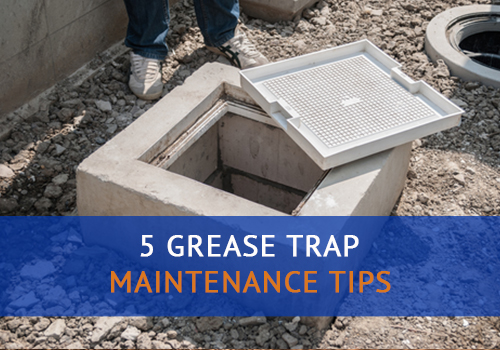Grease traps are valuable appliances in any commercial kitchens. Notably, they are essential to the health of the kitchen and the environment. They keep oils, fats, and grease out of the sewer system, which can wreak havoc on your septic system. Luckily, grease trap maintenance doesn’t have to be hard.
The state of Florida has several codes and regulations that grease traps must comply with. Part of that includes proper installation and regular maintenance. Grease traps can be dangerous if not properly maintained, so knowing how to take care of these appliances are essential.
If you own a commercial kitchen, you know the benefits and the difficulties of maintaining a grease trap. Let’s make it easier for you by reviewing some grease traps maintenance tips.

5 Grease Trap Maintenance Tips
1. Confirm a Proper Installation
You should always check that your grease trap was installed correctly. Never install a grease trap on your own without training. We always suggest that you rely on a trusted professional to do this for you.
A poorly installed grease trap can lead to many complications. However, how do you know you have an install problem?
Check the grease trap after the installation. It should be gathering grease immediately after its first use. If you notice that your grease trap is not containing the oil poured into it, then you could have a leak. More than likely it was installed wrong.
To save yourself money in the long run, hire professionals to do this critical task for you.
2. Discard Solid Food Waste
Grease traps prevent grease, fats, and oils from going down the drain. However, it would be best if you still were careful about what goes into your grease trap.
It’s inevitable that some food particles will make it into the sink. However, this should exclude larger food items, which can be thrown directly into the trash. Don’t rely on your garbage disposal too much.
The more food you can keep out of your grease trap, the better. Which leads us to the next tip, installing strainers.
3. Install Strainers
Install a strainer to keep large food particles or other unwanted items like gloves, silverware, or dishrags out of your grease trap. Too much extra food or random objects in your drains or appliances could cause permanent damage down the road.
Equipping your grease trap with strainers prevents these solids from entering the contraption and your grease trap.
4. Don’t Pour Grease Down the Drain
There are several foods and particles that you should not put down your drain, including grease. It can clog the drain or put more strain than needed on the grease trap.
However, you can pour your grease into a bucket and dispose of it separately. Make sure to use a metal bucket rather than a plastic one. Plastic will melt if the grease is hot enough. It’s better to be safe than sorry.
What do you do with this extra grease? Keep it and give it to the company that pumps the kitchen’s grease trap. They won’t mind, and they can properly dispose of this extra amount of grease.
5. Call a Professional for Grease Trap Maintenance
Grease traps will sometimes get backed up with food particles. If so, call a professional service to drain and clean the trap.
It’s essential that the right tools are used when working on these appliances. Professionals are professionals. Having the proper means and the know-how means they can be more thorough.
You never want to perform maintenance on grease traps yourself. However, there are a few things you can do to manage the grease in your commercial kitchen. Let’s take a look.
4 Ways to Manage Grease and Your Grease Trap
1. Reuse Clean Oil
If the oil from a pan can be reused, do it. Clean, particle-free oil can be used in many ways, including greasing a baking dish. This will cut down on the amount of grease your kitchen has to process.
2. Clean Dishes Before the Dishwasher
You know to scrape or wipe the food from a plate directly into the trash. However, taking the extra moment to wipe it down thoroughly will minimize the amount of grease that goes into your sink.
3. Bake, Don’t Fry
Baking uses less oil than frying. This means there’s less oil that needs to be discarded later. If you make this switch, your kitchen will see less grease output than if you continue frying foods.
4. Regularly Clean Your Grease Trap
We can’t say this enough. As your grease trap gets used, the build-up of oil, fats, and grease will accumulate. Regular maintenance, depending on your kitchen, could be about once a week. Establish a cleaning schedule with a company ASAP.
Grease trap maintenance doesn’t have to be hard. In fact, it is more about small, daily habits that will save you money (and headaches) in the long run while also keeping your grease trap and septic system happy.
As always, if you have any questions about our services or grease trap maintenance, give us a call at Advanced Septic Services at 352.242.6100.

